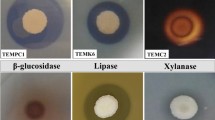Abstract
A total of 239 yeast strains was isolated from 52 tree bark samples of the Medaram and Srisailam forest areas of Andhra Pradesh, India. Based on analysis of D1/D2 domain sequence of 26S rRNA gene, 114 strains were identified as ascomycetous; 107 strains were identified as basidiomycetous yeasts; and 18 strains were identified as yeast-like fungi. Among the ascomycetous yeasts, 51% were identified as members of the genus Pichia, and the remaining 49% included species belonging to the genera Clavispora, Debaryomyces, Kluyveromyces, Hanseniaspora, Issatchenkia, Lodderomyces, Kodamaea, Metschnikowia, and Torulaspora. The predominant genera in the basidiomycetous yeasts were Cryptococcus (48.6%), Rhodotorula (29%), and Rhodosporidium (12.1%). The yeast-like fungi were represented by Aureobasidium pullulans (6.7%) and Lecythophora hoffmanii (0.8%). Of the 239 yeast strains tested for Xylanase, only five strains of Aureobasidium sp. produced xylanase on xylan-agar medium. Matrix-assisted laser desorption ionization-time of flight analysis and N-terminal amino-acid sequence of the xylanase of isolate YS67 showed high similarity with endo-1-4-β-xylanase (EC 3.2.1.8) of Aureobasidium pullulans var. melanigenum.

Similar content being viewed by others
References
Basaran P, Hang YD, Basaran N, Worobo RW (2001) Cloning and heterologous expression of xylanase from Pichia stipitis in Escherichia coli. J Appl Microbiol 90:248–255
Bhadra B, Sreenivas Rao R, Naveen NN, Chaturvedi P, Sarkar PK, Shivaji S (2007) Pichia cecembensis sp. nov. isolated from a papaya fruit (Carica papaya L., Caricaceae). FEMS Yeast Res 7:579–584
Biely P, Vrsanska M, Kratky Z (1980) Xylan degrading enzymes of the yeast Cryptococcus albidus. Eur J Biochem 108:313–321
Bull AT, Goodfellow M, Slater JH (1992) Biodiversity as a source of innovation in biotechnology. Ann Rev Microbiol 46:219–252
Butinar L, Santos S, Spencer-Martins I, Oren A, Gunde-Cimeraman N (2005) Yeast diversity in hypersaline habitats. FEMS Microbiol Lett 244:229–234
Butinar L, Spencer-Martins I, Gunde-Cimerman N (2007) Yeasts in high Arctic glaciers: The discovery of a new habitat for eukaryotic microorganisms. Antonie van Leeuwenhoek 91:277–289
Correria A, Sampaio P, Almeida J, Pais C (2004) Study of molecular epidemiology of candidiasis in Portugal by PCR fingerprinting Candida clinical isolates. J Clin Microbiol 42:5899–5903
Fell JW, Boekhout T, Fonseca A, Scorzetti G, Statzell-Tallman A (2000) Biodiversity and systematics of basidiomycetous yeasts as determined by large-subunit rDNA D1/D2 domain sequence analysis. Int J Syst Evol Microbiol 50:1351–1371
Kumar S, Tamura K, Nei M (2004) MEGA3.1: Integrated software for molecular evolutionary genetics analysis and sequence alignment. Brief Bioinform 5:50–163
Kurtzman CP, Fell JW (1998) The yeast: a taxonomic study, 4th ed. Elsevier, New York, NY
Kurtzman CP, Robnett CJ (1998) Identification and phylogeny of ascomycetous yeasts from analysis of nuclear large subunit (26S) ribosomal DNA partial sequences. Antonie van Leeuwenhoek 73:331–371
Laemmli UK (1970) Cleavage of structural proteins during the assembly of head of bacteriophage T4. Nature 227:680–685
Leathers TD (1986) Color variants of Aureobasidium pullulans overproduce xylanase with extremely high specific activity. Appl Environ Microbiol 52:1026–1030
Miller GL (1959) Use of dinitrosalicylic acid reagent for determination of reducing sugar. Anal Chem 31:426–428
Morais PB, Teixeira LCRS, Bowles JM, Lachance MA, Rosa CA (2004) Ogataea falcaomoraisii sp. nov., a sporogenous methylotrophic yeast from tree exudates. FEMS Yeast Res 5:81–85
Ohta K, Moriyama S, Tanaka H, Shige T, Akimoto H (2001) Purification and characterization of an acidophilic xylanase from Aureobasidium pullulans var. melanigenum and sequence analysis of the encoding gene. J Biosci Bioeng 92:262–270
Peter G, Lehoczki JT, Fulop L, Dlauchy D (2003) Six new methanol assimilating yeast species from wood material. Antonie van Leeuwenhoek 84:147–159
Randhawa HS, Mussa AY, Khan ZU (2000) Decaying wood in tree trunk hollows as a natural substrate for Cryptococcus neoformans and other yeast-like fungi of clinical interest. Mycopathologia 151:63–69
Rao SR, Bhadra B, Kumar NN, Shivaji S (2007) Candida hyderabadensis sp. nov., a novel ascomycetous yeast isolated from wine grapes. FEMS Yeast Res 7:489–493
Scorzetti G, Petrescu I, Yarrow D, Decreased JW (2000) Cryptococcus adeliensis sp. nov., a xylanase producing basidiomycetous yeast from Antarctica. Antonie van Leeuwenhoek 77:153–157
Slavikova E, Vadkertiova R (2003) The diversity of yeasts in the agricultural soil. J Basic Microbiol 43:430–436
Suh SO, Blackwell M (2004) Three new beetle-associated yeast species in the Pichia guilliermondii clade. FEMS Yeast Res 4:87–95
Suh S-O, Gibson CM, Blackwell M (2004) Metschnikowia chrysoperlae sp. nov., Candida picachoensis sp. nov. and Candida pimensis sp. nov., isolated from the green lacewings Chrysoperla comanche and Chrysoperla carnea (Neuroptera: Chrysopidae). Int J Syst Evol Microbiol 54:1883–1890
Tanaka H, Okuno T, Moriyama S, Muguruma M, Ohta K (2004) Acidophilic xylanase from Aureobasidium pullulans: efficient expression and secretion in Pichia pastoris and mutational analysis. J Biosci Bioeng 98:338–343
Thompson JD, Gibson TJ, Plewniak F, Jeanmougin F, Higgins DG (1997) The CLUSTAL_X windows interface: Flexible strategies for multiple sequence alignment aided by quality analysis tools. Nucleic Acids Res 25:4876–4882
Yarrow D (1998) Methods for the isolation, maintenance and identification of yeasts. In: Kurtzman CP, Fell JW (eds) The yeasts, a taxonomic study, 4th ed. Elsevier, Amsterdam, The Netherlands
Acknowledgments
The yeast strains were isolated as part of a project funded by the Council of Scientific and Industrial Research, New Delhi, India (S. S.) to characterize methylotrophic yeasts from the environment. We are also thankful to C. Kurtzman of Agricultural Research Service Culture Collection (Peoria, IL) for providing type strains for the study.
Author information
Authors and Affiliations
Corresponding author
Electronic supplementary material
Below is the link to the electronic supplementary material.
Rights and permissions
About this article
Cite this article
Bhadra, B., Rao, R.S., Singh, P.K. et al. Yeasts and Yeast-Like Fungi Associated with Tree Bark: Diversity and Identification of Yeasts Producing Extracellular Endoxylanases. Curr Microbiol 56, 489–494 (2008). https://doi.org/10.1007/s00284-008-9108-x
Received:
Accepted:
Published:
Issue Date:
DOI: https://doi.org/10.1007/s00284-008-9108-x




